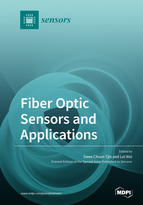Fiber Optic Sensors and Applications
A special issue of Sensors (ISSN 1424-8220). This special issue belongs to the section "Physical Sensors".
Deadline for manuscript submissions: closed (29 February 2020) | Viewed by 47504
Special Issue Editors
Interests: fibre optic sensors; biomedical engineering and biophotonics
Special Issues, Collections and Topics in MDPI journals
Interests: fiber sensors; multifunctional fibers; fiber-based wearable electronics
Special Issues, Collections and Topics in MDPI journals
Special Issue Information
Dear Colleagues,
This Special Issue focusses on all aspects of the recent research and development related to fibre optic sensors. The recent advances in fiber-based sensing technologies have enabled both fundamental studies and a wide spectrum of applications. The goal of this special issue is to bring attention to the most recent results in the field of fiber optic sensors, including new mechanisms, materials, processes and applications. Contributions on applications of novel or existing fibre optic sensors are also welcome, especially highlighting the opportunities offered by the unique features in optical fibres, or the advantages of fibre sensor configuration with respect to current technologies.
Relevant topics include, but are not limited to:
- Advanced fibre design and fabrication for sensing applications.
- Fibre sensors for mechanical, chemical, environmental, biological and medical applications.
- Applications in industrial, life sciences, oil and gas, civil engineering, materials and defence.
- Micro- and nano-structured fibre sensors.
- Fibre lasers for sensing applications.
- Distributed sensing.
- Sensor integration and data fusion, network architectures, packaging, and long-term reliability.
- Lab-on-fibres.
- AI-enabled fibre optic sensing and data processing.
Prof. Dr. Swee Chuan Tjin
Prof. Dr. Lei Wei
Guest Editors
Manuscript Submission Information
Manuscripts should be submitted online at www.mdpi.com by registering and logging in to this website. Once you are registered, click here to go to the submission form. Manuscripts can be submitted until the deadline. All submissions that pass pre-check are peer-reviewed. Accepted papers will be published continuously in the journal (as soon as accepted) and will be listed together on the special issue website. Research articles, review articles as well as short communications are invited. For planned papers, a title and short abstract (about 100 words) can be sent to the Editorial Office for announcement on this website.
Submitted manuscripts should not have been published previously, nor be under consideration for publication elsewhere (except conference proceedings papers). All manuscripts are thoroughly refereed through a single-blind peer-review process. A guide for authors and other relevant information for submission of manuscripts is available on the Instructions for Authors page. Sensors is an international peer-reviewed open access semimonthly journal published by MDPI.
Please visit the Instructions for Authors page before submitting a manuscript. The Article Processing Charge (APC) for publication in this open access journal is 2600 CHF (Swiss Francs). Submitted papers should be well formatted and use good English. Authors may use MDPI's English editing service prior to publication or during author revisions.
Keywords
- fiber optic sensors
- fabrication of fiber sensors
- fiber lasers
- multifunctional sensors
- biophotonics
- sensing systems
- sensing signal and data processing








